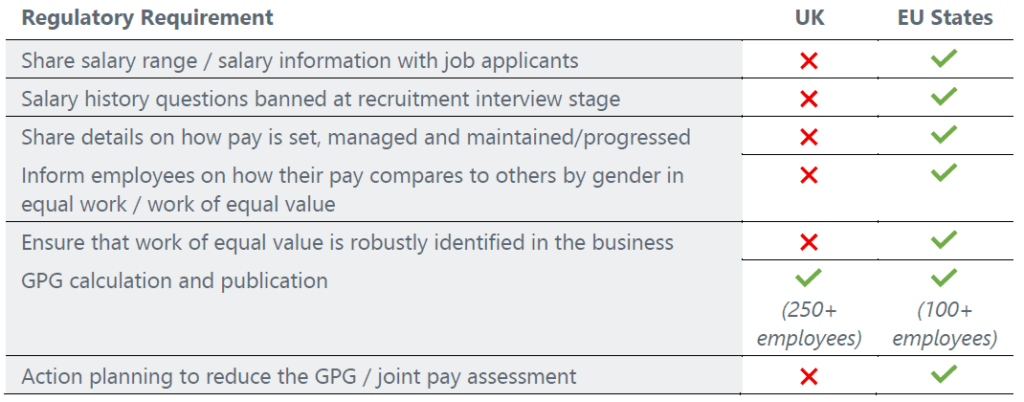Ellason lens on… pay transparency in the UK
Fri 11, July
Pay Transparency regulations are becoming a common feature of the international regulatory landscape. The EU has a new set of Pay Transparency requirements which come into effect no later than June 2026, with some markets adopting a much earlier implementation date, e.g. Poland (November 2025) and Malta (August 2025). Beyond the EU, pay transparency requirements have been implemented by a growing number of US States and Canadian Provinces, as well as across Asia and South America.
The lack of progress in the UK is notable against this backdrop of progress globally, but this now looks set to change.
The current UK context
The UK has had mandatory gender pay gap (GPG) reporting in place for large employers (>250 employees) since 2017. However, the current GPG regulations appear to be having a limited impact:
- Evidence suggests that many employers are simply treating the GPG reporting process as a compliance ‘tick-box’ exercise, with action plans copied from one year to the next.
- The GPG is falling, but only very slowly.
A similar trend had been observed in the EU. Policymakers there were frustrated by the lack of progress and, as a result, developed the EU pay transparency directive in 2023 which is intended to drive the principle of ‘equal pay for work of equal value’ through increased pay transparency.
These new regulations in the EU highlight the lack of progress in the UK to date:

The UK Labour Party was reported to have investigated, and responded positively, to the EU pay transparency regulations in the run-up to the 2024 general election. As a result, when elected into Government, it was always felt to be only a matter of time before the UK developed its own set of rules.
Recent developments in the UK
A Government consultation on extending the current GPG requirements to include ethnicity and disability closed in early June 2025. Government guidelines on ethnicity classifications are already in place and can be found [HERE]; while as yet unconfirmed, it is anticipated that ethnicity and disability pay gap reporting will be required from 2027 based on a 2026 snapshot of data. An additional Government consultation process, which reviewed pay transparency opportunities in the UK, has concluded in the last few days. It is too early to speculate on its conclusions, but there appears to be some evidence of a potential and partial alignment of UK thinking to some of the EU requirements.
Ellason commentary
Increased pay transparency regulations are now expected to be on the way for UK employers. It may be some months yet before we know the precise form they will take, but the EU requirements are a likely template for what may be on the horizon.
Evidence suggests that the UK must act if it is serious about wanting to close its pay gaps. Current GPG reporting requirements are failing to deliver a significant impact in isolation, and the UK will need to keep pace if it is to maintain with credibility, its position as a global advocate for equality. Other countries are being more proactive in addressing pay gaps and the UK risks getting left behind.
Against this backdrop, it should be no surprise that the UK Government is planning to act, and UK employers need to prepare to be more transparent on how they manage and deliver reward. Increased pay transparency requires careful planning and preparation; in most cases, this will require employers to start with the basics (e.g. ensuring they have a clear and defensible grade structure, underpinned by an analytical job evaluation scheme) and using this as a robust platform on which other reward practices can be built.
However, pay transparency can also provide a competitive advantage for companies which embrace it as an opportunity rather than a threat. Experience shows that employees value clarity and respond positively to increased transparency. Early adopters of the EU regulations are already reporting anecdotal improvements in employee engagement and retention, and are registering increasing numbers of applicants per available role.
UK employers are encouraged to start their planning now.